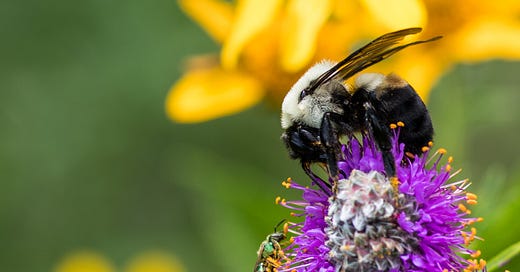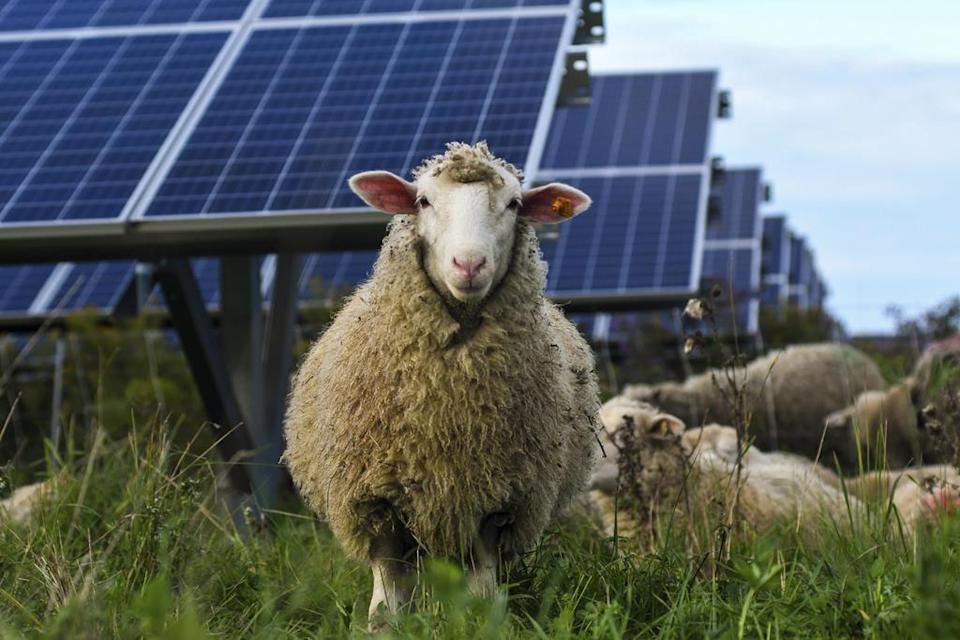Halting pollinator crisis requires entomologists to step up. As-needed pesticide use increases wild bees and yields. ‘Mad-looking’ plant installation suits pollinators’ tastes.
Keeping you connected to the world of bees
Was this email forwarded to you? Sign up here.
Conservation
(Current Opinion in Insect Science) “The decline of bees and other pollinators continues at a high pace, and time for action is running out. Entomologists are holders of expertise that could be the key to halt and reverse the crisis of pollinator decline. This gives entomologists a unique societal responsibility, on par only with the one expected from them in the Western world a century ago on combatting vector diseases and plant pests. Then they invented strong chemicals and biological control. Today, they need to work with and for insects, in a much more complex settings but in a more positive and nurturing attitude.”
Population of native bees is on the rise in Missouri
(Columbia Missourian) Preliminary data from a study conducted by the Missouri Department of Conservation, the University of Missouri, Quail Forever and the Xerces Society shows some promising news concerning bee life in Missouri. The American bumble bee, which is being considered for federal endangered species protection, was commonly found in the study. And a species of bee that was thought to no longer exist in Missouri was found.
Invasive Asian hornets discovered in UK
(BBC) An Asian hornet nest has been discovered and destroyed in Hampshire, the second confirmed sighting of the invasive species in the U.K. this year. A Department for Environment, Food and Rural Affairs spokesperson said, “We are aware of the potential impacts Asian hornets could have on honey bees and other pollinators and have plans in place to take action when the hornets are found in the U.K.”
History of insect invasions offer insight into the future
(ScienceDaily, USDA Forest Service - Northern Research Station) Results from a recently published study suggest that efforts to reduce biological hitchhiking on live plant imports, often referred to as “biosecurity”, are working. However, more than a century of invasion by Hemiptera insects also suggests that increased trade might offset the effects of improved biosecurity. As many as 25 percent of invading Hemiptera insects may have yet to be detected in the nation's forests and agricultural fields.
Are these the world’s most eco-friendly dogs?
(Columbia Insight) Guiding, herding, retrieving, rescuing, therapy’ing, sniffing out contraband, fetching slippers – dogs can be pretty impressive workers. Now an elite pack of conservation-oriented canines is directing its snouts toward rooting out invasive wild plant species that threaten vulnerable Western ecosystems.
Economics
Bees, sheep, crops: Solar developers tout multiple benefits
(AP) Silflower was among native plants that blanketed the vast North American prairie until settlers developed farms and cities. Nowadays confined largely to roadsides and ditches, the long-stemmed cousin of the sunflower may be poised for a comeback, thanks to solar energy. Researchers are growing silflower at nine solar installations in the Minneapolis area, testing its potential as an oilseed crop. The deep-rooted perennial also offers forage for livestock and desperately needed habitat for bees, butterflies and hummingbirds. “The solar industry is interested in restoring pollinator habitat. This seemed to be a good partnership.”
Manitoba honey bees hit with pesky symptoms
(Manitoba Co-operator) While an extended season has been a boon for the honey sector, experts say it may have also played into the varroa mite issues that have plagued some operations. The chair of the Manitoba Beekeepers’ Association said producers reported higher mite counts this year, requiring treatment. “There were some cases where mite populations got out of control. But, for the most part, I’m hearing most beekeepers have been able to manage the mites accordingly.”
Savannah Bee Company store in Connecticut set to close in December
(Westport News) The niche experiential store has been in Westport selling bee-based products since 2017. The Georgia-based business was started in 2002, and has since grown to over 100 employees and 15 locations with retail stores in Tennessee, Georgia, Arizona, South Carolina, Florida, Colorado and Connecticut. The store manager says the company has been successful in teaching residents about the importance of bees and pollinators in general.
Policy/Law
Biden admin revives talks on endangered species and pesticides
(E&E Greenwire) A federal interagency task force on pesticides and endangered species has resumed its work after a long delay, pledging smoother consultations among EPA, the Interior Department and the Department of Agriculture. In a news release, EPA said the group met Oct. 15 and agreed on general priorities including working more closely with outside groups and using pilot programs to reduce pesticides’ effects on endangered species. At issue are the consultations among various agencies – also including the Council on Environmental Quality and NOAA – on the use of pesticides that might pose a threat to vulnerable wildlife and plants.
Report on threats to bees and pollinator plan presented to Irish councilors
(Derry Journal) Members of Derry City and Strabane Environment and Regeneration Committee were enthusiastic in their support for a report brought by Biodiversity Officer, Dr. Christine Doherty, detailing the council’s targets for pollinator conservation in council-owned green spaces, keeping in line with the all-Ireland Pollinator Plan 2021-25.
Science
As-needed pesticide use brings wild bees, increases watermelon yield without reducing corn profits
(Phys.org, Purdue University) Many farmers rent bee hives to pollinate crops, but they could tap into the free labor of wild bees by adopting an as-needed approach to pesticides, a new proof-of-concept study shows. A multiyear study of commercial-scale fields in the Midwest found this approach led to a 95% reduction in pesticide applications, while maintaining or increasing crop yield for corn and watermelon. “With reduced pesticide use, we saw within the first year wild bees returned to the fields, and our findings showed an average 26% increase in watermelon yield.”
Honey bees use social distancing when mites threaten hives
(The Guardian) In the past 18 months humans have become all too familiar with the term “social distancing”. But it turns out we are not the only ones to give our peers a wide berth when our health may be at risk: research suggests honey bees do it too. Scientists have found that when a hive of honey bees is under threat from the mite Varroa destructor the bees respond by changing the way they interact with one another.
See through the glasswing butterfly’s fascinating wings
(Scientific American) True to their name, glasswing butterflies sport remarkably transparent wings that help them hide in plain sight. New work shows how narrow, bristle-like scales and a waxy, glare-cutting coating combine to make parts of the wings nearly invisible.
Intriguing insect fossils preserved in amber
(ScienceDaily, Ludwig-Maximilians-Universität München) All fossils are time capsules. But unlike many other finds, insects encapsulated in amber are often perfectly preserved. Researchers have now obtained new insights into the evolutionary history of insects from specimens that were trapped in natural tree resins 100 million years ago, in forests in what is now Myanmar.
Society/Culture
‘Mad-looking’ installation suits pollinators’ tastes
(The Guardian) The plant-based piece in the U.K. used an algorithm to make a design irresistible to bees, butterflies, moths and wasps. “It means that I’ve ended up with this mad-looking design. There are strange juxtapositions of shapes and patterns and colours that no gardener would think of planting. It is designed to be of greatest benefit to pollinators, suiting their tastes rather than ours.”
Bumble bee project to receive UK lottery funding
(BBC) A project to increase bee numbers across the Peak District has been handed a National Lottery award. Pollinating the Peak was set up in 2015 to protect and save a local species: the Bilberry bumble bee. The project beat 16 other finalists and picked up 4,000 votes from the public to win the Project of the Year trophy.
Technology
When bees can’t pollinate a flower, this agricultural robot steps in
(Fast Company) The StickBug, a project from researchers at West Virginia University with funding from the U.S. Department of Agriculture, will use computer vision algorithms to map out indoor environments and learn where flowers on the plants are, and which flowers need to be pollinated. Then it will reach out its arms to pollinate those flowers.
(Yahoo!Finance, Newsfile Corp.) American Aires Inc. has announced a new field study aimed at observing the effectiveness of their Lifetune technology as a solution for reducing the harmful effects of exposure to electromagnetic fields on honey bees. This study will be open to small-scale commercial and hobbyist beekeepers in the US and Canada.
UC Santa Barbara leading new NSF grant to digitize more than 1.5 million bee images
(UC Santa Barbara) The multimillion-dollar, multi-institution project being led by UC Santa Barbara aims to illuminate what’s driving bees’ decline by addressing that lack of data. With $3 million from the National Science Foundation and a three-year timeline, the collaborative effort will create more than 1.3 million bee specimen images from 5,509 agriculturally and phylogenetically important global bee species.
One More Thing…
Cartoon by Jimmy Craig, via The New Yorker.










